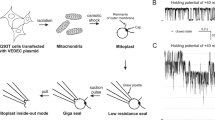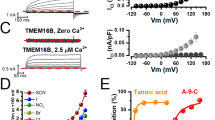Abstract
Electrogenic Na-Ca exchange has been known to act in the cardiac sarcolemma as a major mechanism for extruding Ca ions1–3. Ionic flux measurements in cardiac vesicles have recently suggested that the exchange ratio is probably 3 Na:l Ca (refs 4, 5), although a membrane current generated by such a process has not been isolated. Using the intracellular perfusion technique6,7 combined with the whole-cell voltage clamp8, we were able to load Na+ inside and Ca2+ outside the single ventricular cells of the guinea pig and have succeeded in recording an outward Na-Ca exchange current while blocking most other membrane currents. The current is voltage-dependent, blocked by La3+ and does not develop in the absence of intracellular free Ca2+. This report presents the first direct measurement of the cardiac Na-Ca exchange current, and should facilitate the study of Ca2+ fluxes during cardiac activity, together with various electrical changes attributable to the Na-Ca exchange9 and the testing of proposed models10–12.
This is a preview of subscription content, access via your institution
Access options
Subscribe to this journal
Receive 51 print issues and online access
$199.00 per year
only $3.90 per issue
Buy this article
- Purchase on Springer Link
- Instant access to full article PDF
Prices may be subject to local taxes which are calculated during checkout
Similar content being viewed by others
References
Reuter, H. & Seitz, N. J. Physiol., Lond. 195, 451–470 (1968).
Glitsch, H. G., Reuter, H. & Scholz, H. J. Physiol., Lond. 209, 25–43 (1970).
Mullins, L. J. Ion Transport in Heart (Raven, New York, 1981).
Pitts, B. J. J. biol. Chem. 254, 6232–6235 (1979).
Reeves, J. P. & Hale, C. C. J. biol. Chem. 259, 7733–7739 (1984).
Soejima, M. & Noma, A. Pflügers Arch. ges. Physiol. 400, 424–431 (1984).
Matsuda, H. & Noma, A. J. Physiol., Lond. 357, 553–573 (1984).
Hamill, O. P., Marty, A., Neher, E., Sakmann, B. & Sigworth, J. Pflügers Arch. ges. Physiol. 391, 85–100 (1981).
Eisner, D. A. & Lederer, W. J. Am. J. Physiol. 248, C189–C202 (1985).
Mullins, L. J. J. gen. Physiol. 70, 681–695 (1977).
DiFrancesco, D. & Noble, D. Phil. Trans. R. Soc. B307, 353–398 (1985).
Johnson, E. A. & Kootsey, J. M. J. Membrane Biol. 86, 167–187 (1985).
Baker, P. F. & McNaughton, P. A. J. Physiol., Lond. 259, 103–144 (1976).
Allen, T. J. A. & Baker, P. F. Nature 315, 755–756 (1985).
Fabiato, A. & Fabiato, F. J. Physiol., Paris 25, 463–505 (1979).
Author information
Authors and Affiliations
Rights and permissions
About this article
Cite this article
Kimura, J., Noma, A. & Irisawa, H. Na-Ca exchange current in mammalian heart cells. Nature 319, 596–597 (1986). https://doi.org/10.1038/319596a0
Received:
Accepted:
Issue Date:
DOI: https://doi.org/10.1038/319596a0
This article is cited by
-
Mechanism of extracellular ion exchange and binding-site occlusion in a sodium/calcium exchanger
Nature Structural & Molecular Biology (2016)
-
Nicorandil stimulates a Na+/Ca2+ exchanger by activating guanylate cyclase in guinea pig cardiac myocytes
Pflügers Archiv - European Journal of Physiology (2016)
-
In the squid axon Na+/Ca2+ exchanger the state of the Cai-regulatory site influences the affinities of the intra- and extracellular transport sites for Na+ and Ca2+
Pflügers Archiv - European Journal of Physiology (2008)
Comments
By submitting a comment you agree to abide by our Terms and Community Guidelines. If you find something abusive or that does not comply with our terms or guidelines please flag it as inappropriate.



